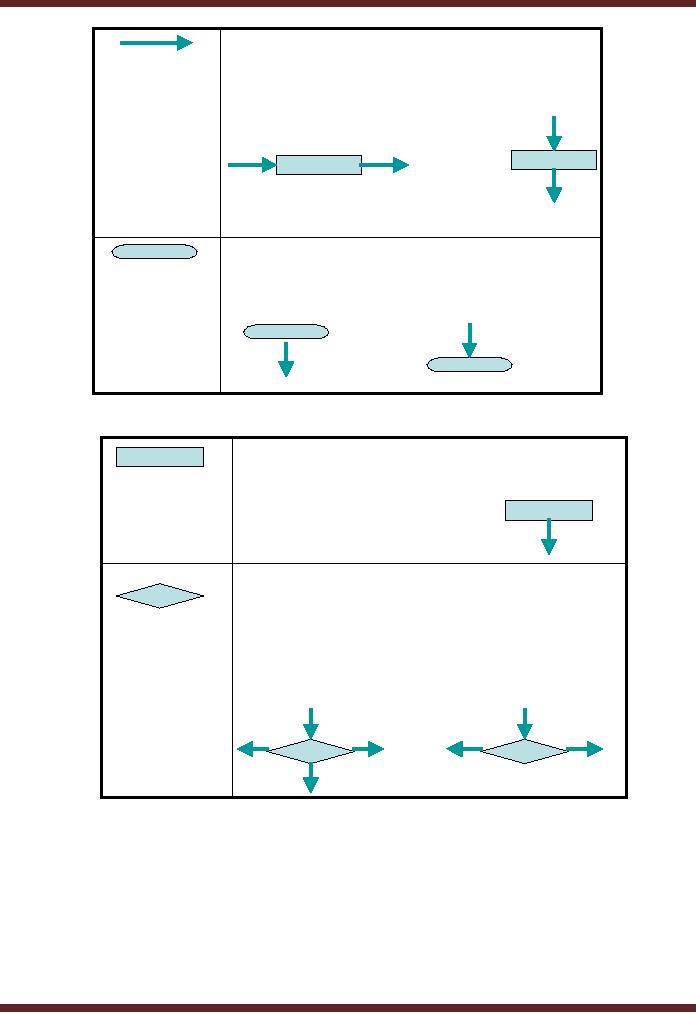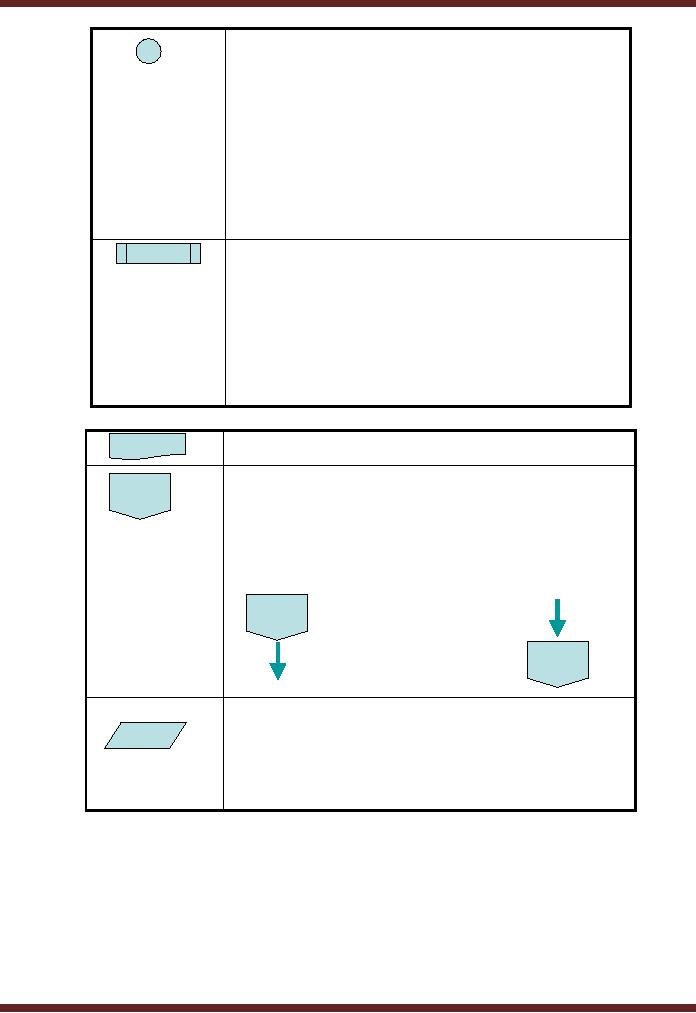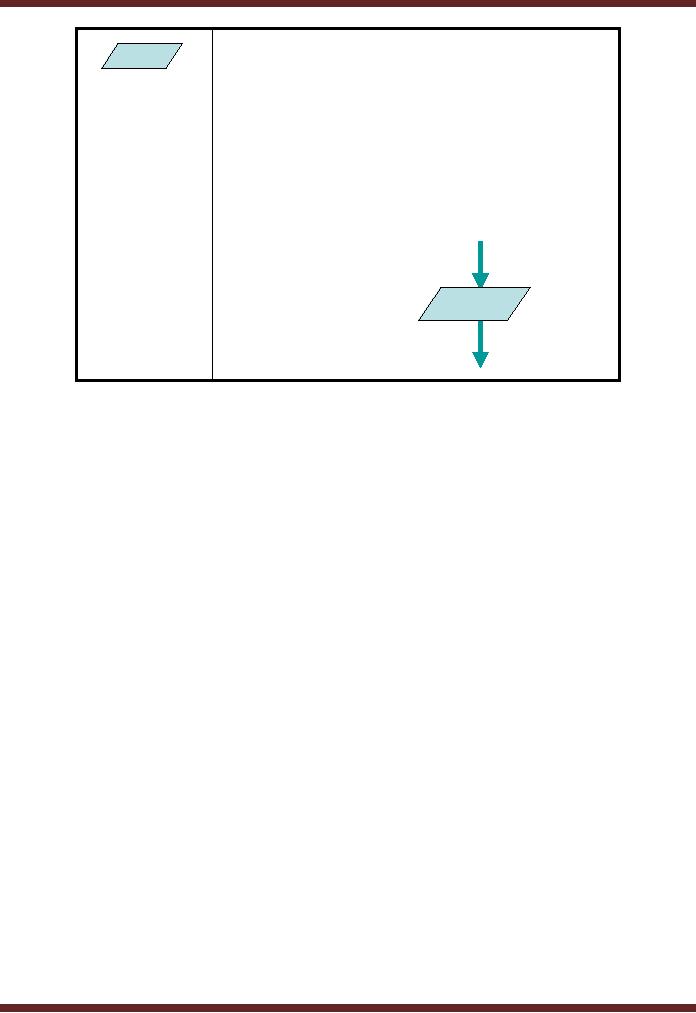 |

VU
Information
System (CS507)
Arrow
The usual
direction of the flow of
a
procedure or
system is from left
to
right or
top to bottom.
or
Ensure
that the flowchart has
a
logical
start and finish.
Terminator
Only one
flow line is used in
conjunction
with terminator
symbol.
Process
Only one flow line
should come out
from a
process symbol.
Decision
Only one
flow line should enter a
decision
symbol,
but two or three flow
lines, one for
each
possible answer, should
leave the
decision
symbol
<0
>0
=0
<0
>0
97

VU
Information
System (CS507)
Connectors
If the
flowchart becomes complex,
it
is better to
use connector symbols
to
reduce the
number of flow lines.
Avoid the
intersection of flow lines
if
you want
to make it more effective
and better
way of communication.
Predefined
Process
This
represents a named process
consisting of
one or more
operations
or program
steps specified
elsewhere
Single
Document
Off-Page
Connector
Use to connect
remote flowchart portion
on
different
pages. One flow line enters
or
exits.
Input /
Output
Used
whenever data is into the
flowchart or
displayed
from the flowchart. A single
flow
line
enters and a single line
exits.
98

VU
Information
System (CS507)
Input /
Output
� Used whenever
data is entered
into the
flowchart or displayed
from the
flowchart.
�
A single
flow line enters and
a
single
line exits.
Good
Practices
Like
every other methodology, flow
charts also have a set of
recommended practices for
flow charts:
�
In drawing a
proper flowchart, all
necessary steps that are a
part of process should be listed
out in
logical
order.
�
The
flowchart should be clear, neat
and easy to follow. There should
not be any room
for
ambiguity in
understanding the flowchart.
�
It is
useful to test the validity of the
flowchart.
99
Table of Contents:
- Need for information, Sources of Information: Primary, Secondary, Tertiary Sources
- Data vs. Information, Information Quality Checklist
- Size of the Organization and Information Requirements
- Hierarchical organization, Organizational Structure, Culture of the Organization
- Elements of Environment: Legal, Economic, Social, Technological, Corporate social responsibility, Ethics
- Manual Vs Computerised Information Systems, Emerging Digital Firms
- Open-Loop System, Closed Loop System, Open Systems, Closed Systems, Level of Planning
- Components of a system, Types of Systems, Attributes of an IS/CBIS
- Infrastructure: Transaction Processing System, Management Information System
- Support Systems: Office Automation Systems, Decision Support Systems, Types of DSS
- Data Mart: Online Analytical Processing (OLAP), Types of Models Used in DSS
- Organizational Information Systems, Marketing Information Systems, Key CRM Tasks
- Manufacturing Information System, Inventory Sub System, Production Sub System, Quality Sub system
- Accounting & Financial Information Systems, Human Resource Information Systems
- Decision Making: Types of Problems, Type of Decisions
- Phases of decision-making: Intelligence Phase, Design Phase, Choice Phase, Implementation Phase
- Planning for System Development: Models Used for and Types of System Development Life-Cycle
- Project lifecycle vs. SDLC, Costs of Proposed System, Classic lifecycle Model
- Entity Relationship Diagram (ERD), Design of the information flow, data base, User Interface
- Incremental Model: Evaluation, Incremental vs. Iterative
- Spiral Model: Determine Objectives, Alternatives and Constraints, Prototyping
- System Analysis: Systems Analyst, System Design, Designing user interface
- System Analysis & Design Methods, Structured Analysis and Design, Flow Chart
- Symbols used for flow charts: Good Practices, Data Flow Diagram
- Rules for DFD’s: Entity Relationship Diagram
- Symbols: Object-Orientation, Object Oriented Analysis
- Object Oriented Analysis and Design: Object, Classes, Inheritance, Encapsulation, Polymorphism
- Critical Success Factors (CSF): CSF vs. Key Performance Indicator, Centralized vs. Distributed Processing
- Security of Information System: Security Issues, Objective, Scope, Policy, Program
- Threat Identification: Types of Threats, Control Analysis, Impact analysis, Occurrence of threat
- Control Adjustment: cost effective Security, Roles & Responsibility, Report Preparation
- Physical vs. Logical access, Viruses, Sources of Transmissions, Technical controls
- Antivirus software: Scanners, Active monitors, Behavior blockers, Logical intrusion, Best Password practices, Firewall
- Types of Controls: Access Controls, Cryptography, Biometrics
- Audit trails and logs: Audit trails and types of errors, IS audit, Parameters of IS audit
- Risk Management: Phases, focal Point, System Characterization, Vulnerability Assessment
- Control Analysis: Likelihood Determination, Impact Analysis, Risk Determination, Results Documentation
- Risk Management: Business Continuity Planning, Components, Phases of BCP, Business Impact Analysis (BIA)
- Web Security: Passive attacks, Active Attacks, Methods to avoid internet attacks
- Internet Security Controls, Firewall Security SystemsIntrusion Detection Systems, Components of IDS, Digital Certificates
- Commerce vs. E-Business, Business to Consumer (B2C), Electronic Data Interchange (EDI), E-Government
- Supply Chain Management: Integrating systems, Methods, Using SCM Software
- Using ERP Software, Evolution of ERP, Business Objectives and IT
- ERP & E-commerce, ERP & CRM, ERP– Ownership and sponsor ship
- Ethics in IS: Threats to Privacy, Electronic Surveillance, Data Profiling, TRIPS, Workplace Monitoring